Copyright Basics
> Msjaniceanderson
My first project – MyBib. What is MyBib?

MyBib is a free bibliography and citation generator that makes accurate citations for you to copy straight into your academic assignments and papers. If you’re a student, academic, or teacher, and you’re tired of the other bibliography and citation tools out there, then you’re going to love MyBib. MyBib creates accurate citations automatically for books, journals, websites, and videos just by searching for a title or identifier (such as a URL or ISBN). Plus, we’re using the same citation formatting engine as professional-grade reference managers like Zotero and Mendeley, so you can be sure our bibliographies are perfectly accurate in over 9,000 styles — including APA, Chicago, MLA 7 & 8, and Harvard.
U.S. Copyright Office. ConnectSafely.org/copyright. Video - Copyright School.
Video - Copyright Law and You!
Copyright Videos - Copyright Alliance Videos by Creators. Understanding the DMCA: Elements of a Counter Notice What should you do if you receive a mistaken DMCA takedown request?
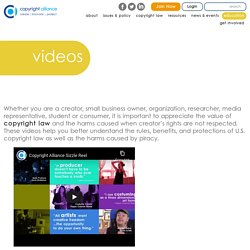
Find out from our latest video!
Video - A Fair(y) Use Tale (NOT a Disney movie)
Information & Copyright Facts. Exceptions and limitations to copyright are special cases defined by law where the general principle that the prior authorization of the rightsholder is necessary to make use of a work does not apply.
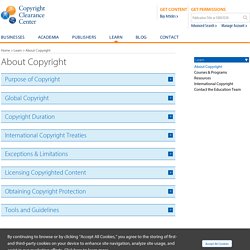
That is, in the public interest of maintaining a balance between the interests of rightsholders and those of content users, copyright-protected works may in some cases be used without the authorization of the rightsholder. Generally, exceptions and limitations to copyright are subject to a three-step test initially set out in the Berne Convention and repeated in a number of other international agreements. Briefly stated, the Berne Convention provides that an exception or limitation to copyright is permissible only if (1) it covers only special cases, (2) it does not conflict with the normal exploitation of the work, and (3) it does not unreasonably prejudice the legitimate interests of the author.
Video - Copyright Clearance Center: Copyright Basics. Copyright Is Essential (Updated version)
The Educator’s Guide to Creativity & Copyright. Middle School Homepage : Copyright & Creativity.
Copyright for teaching. ALA - Showing movies in face-to-face classrooms. Education. Copyright & Creativity : K-12 Teaching Resources on Copyright and Fair Use. The Four Factors of Fair Use. EFF- Electronic Frontier Foundation: Fair Use. After decades of ever more draconian statutes and judicial decisions, our intellectual property system has veered far away from its original purpose.
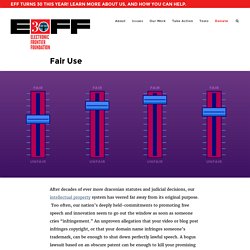
Is Fair Use a License to Steal?
Many educators interpret fair use as freedom to use copyrighted materials as long as their use is restricted to instructional purposes.

Are they correct in that belief? Not exactly! Learn how the law really works.
No One Can Copyright These 15 Things, and They May Surprise You. What is copyright? In short, it’s a legal right for content creators.
Plagiarism Video for Schools. Preventing Plagiarism: Tips and Techniques. Grades 9 – 12 | Lesson Plan | Standard Lesson Creative Outlining-From Freewriting to Formalizing After reading a short story, students use freewriting as a catalyst for a literary analysis essay.
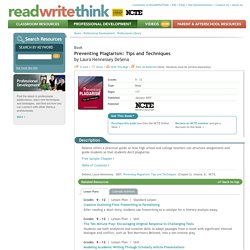
Grades 9 – 12 | Lesson Plan | Unit. Copyleaks: AI & Machine Learning Powered Plagiarism Checker. Plagiarism Checker - Free Online Software by EduBirdie. Plagiarism is one’s deliberate copying of a content completed by another person and either presenting it as one’s own novel idea or simply not mentioning the name of its original author. Plagiarism may be intentional or unintentional when a person does not know that he or she uses someone else’s idea.
Grammarly: Free Writing Assistant. What is Open Source explained in LEGO. What is open source software?
The term "open source" refers to something people can modify and share because its design is publicly accessible.

The term originated in the context of software development to designate a specific approach to creating computer programs. Today, however, "open source" designates a broader set of values—what we call "the open source way.
" Open source projects, products, or initiatives embrace and celebrate principles of open exchange, collaborative participation, rapid prototyping, transparency, meritocracy, and community-oriented development.
Google Open Source – opensource.google.com. Khan Academy - Creative commons and open source. Find free-to-use images - Google Search Help. When you do a Google Search, you can filter your results to find images, videos, or text that you have permission to use.
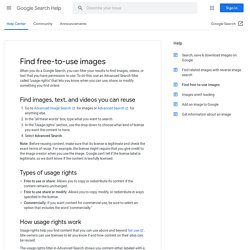
To do this, use an Advanced Search filter called "usage rights" that lets you know when you can use, share, or modify something you find online. Find images, text, and videos you can reuse Go to Advanced Image Search for images or Advanced Search for anything else. In the "all these words" box, type what you want to search. In the "Usage rights" section, use the drop-down to choose what kind of license you want the content to have. Note: Before reusing content, make sure that its license is legitimate and check the exact terms of reuse.
Types of usage rights. What is Creative Commons?
Creative Commons. Commons Wikipedia. Gutenberg - Books in the public domain. Public Domain - Google Books. Government Documents. Links to government publications in the National Archives, gateways and guides to federal information, finding aids and indexes to government documents, federal directories, and other government publications.
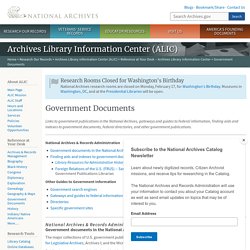
National Archives & Records Administration Other Guides to Government Information National Archives & Records Administration Government documents in the National Archives The major collections of U.S. government publications in the National Archives are in the Library at Archives II; the Center for Legislative Archives, Archives I; and the Microfilm Reading Room, Archives I. Publications not in any of the National Archives collections may be found at the University of Maryland’s McKeldin Library and at other Federal Depository Libraries.
U.S. Government Publishing Office. Music - Public Domain Information Project. Entertainment Law Mythbusters: Your Questions about Legally Sampling Music Answered. The rules around sampling music have been mystifying musicians since the enactment of the Copyright Act of 1976.
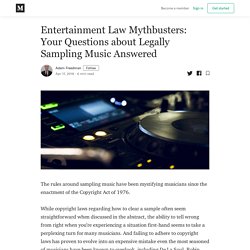
While copyright laws regarding how to clear a sample often seem straightforward when discussed in the abstract, the ability to tell wrong from right when you’re experiencing a situation first-hand seems to take a perplexing turn for many musicians. And failing to adhere to copyright laws has proven to evolve into an expensive mistake even the most seasoned of musicians have been known to overlook, including De La Soul, Robin Thicke, and Led Zeppelin. At the same time, adept music fans are sure to have noticed the decades-long trend of Billboard-topping tracks directly incorporating inspiration from their predecessors in the form of sampling — most recently, Drake who sampled Ms. Lauryn Hill who sampled Wu Tang Clan who sample Gladys Knight and the Pips.
Let’s bust the myths surrounding legal music sampling once and for all. 1. FALSE. 2. FALSE. 3. TRUE. 4. FALSE. 5. FALSE.
How Copyright Works: How Sampling is Different from Stealing. Hawk Library News. "Access to Library Resources and Services for Minors: An Interpretation of the Library Bill of Rights", American Library Association, July 26, 2006.










